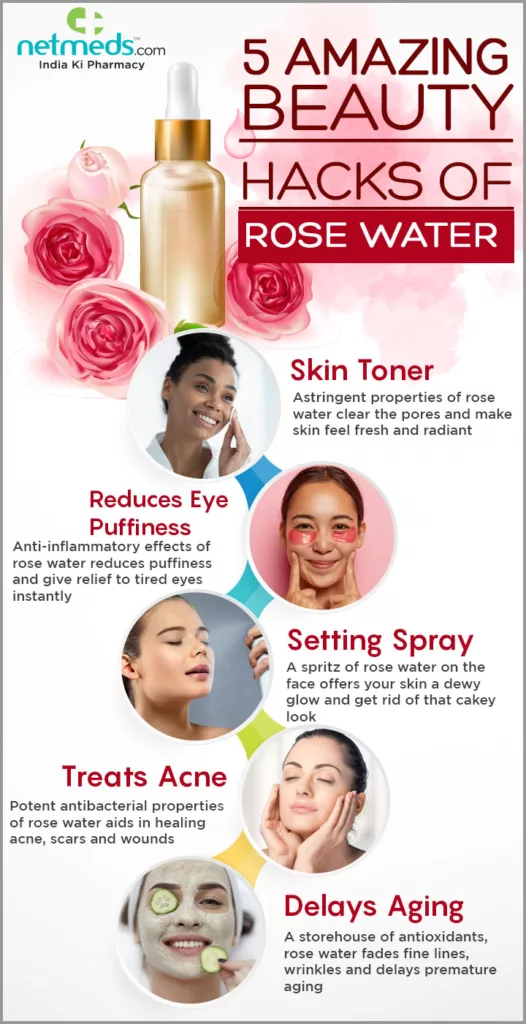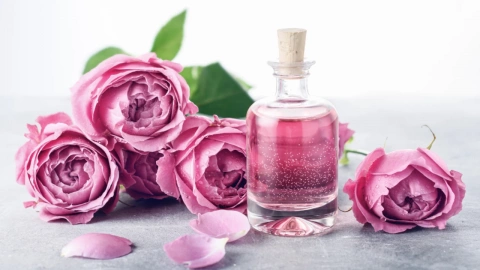Introduction
What is Rose Water?
Rose water is a fragrant liquid made by steeping rose petals in water. It’s often used in cooking, baking, and cosmetics for its delicate floral aroma. Additionally, it has been used for its potential skincare benefits and can be found in various beauty products.
Is there something specific you’d like to know about rose water?

Benefits of rose water
Sure, here are some potential benefits of using rose water:
- Skin Hydration: Rose water can help hydrate and moisturize the skin, making it feel refreshed and rejuvenated.
- Anti-Inflammatory: It has anti-inflammatory properties that may help soothe irritated skin and reduce redness.
- Antioxidant Boost: Rose water contains antioxidants that can help protect the skin from damage caused by free radicals.
- Balancing pH: The natural pH of rose water is close to that of the skin, which can help maintain the skin’s pH balance.
- Acne Prevention: Its antibacterial properties may aid in preventing and treating acne by reducing the growth of bacteria on the skin.
- Skin Toning: Rose water can act as a natural toner, helping to tighten and tone the skin’s pores.
- Aromatherapy: The pleasant fragrance of rose water can have a calming effect and promote relaxation.
- Eye Care: It can be used to soothe tired and puffy eyes, reducing puffiness and providing relief.
- Hair Care: Rose water may improve hair health by moisturizing the scalp, reducing dandruff, and enhancing hair’s natural shine.
- Stress Reduction: The aroma of rose water is often used in aromatherapy to reduce stress and anxiety.
Remember that individual results can vary, and it’s important to perform a patch test before using rose water on your skin to ensure you don’t have any adverse reactions. If you’re considering using rose water for specific health or skincare benefits, it’s a good idea to consult with a dermatologist or healthcare professional.
How to make rose water?

Making rose water at home is a simple process. Here’s a basic method:
Ingredients: Fresh rose petals (make sure they are pesticide-free), Distilled water
Instructions
- Gather Petals: Collect fresh rose petals from roses that have not been treated with pesticides or chemicals. The petals should be clean and dry.
- Rinse Petals: Gently rinse the petals with cold water to remove any dirt or insects. Pat them dry with a clean cloth or paper towel.
- Boil Water: In a pot, pour enough distilled water to cover the rose petals. Distilled water is preferable as it’s free from impurities. Heat the water until it’s just about to boil.
- Add Petals: Once the water is heated, add the rose petals to the pot. Make sure the petals are submerged in the water.
- Simmer: Reduce the heat to low and let the petals simmer in the water. Cover the pot with a lid.
- Collect Rose Water: Place a heatproof bowl or container in the center of the pot. The bowl should be smaller than the pot’s opening, and it should float on the water. The rising steam will condense on the lid and then drip into the bowl.
- Steam and Condensation: As the water simmers, the steam will carry the rose essence and condense on the lid, then drip into the bowl as rose water.
- Cool and Store: Once you’ve collected enough rose water (usually after about 20-30 minutes), remove the container from the pot. Allow the rose water to cool. Transfer it to a clean, airtight bottle or container for storage. Store it in the refrigerator to prolong its shelf life.
Keep in mind that the potency of the rose water might vary depending on the type of roses used and the concentration of petals. This homemade rose water can be used for skin care, cooking, or other applications.
Remember to do a patch test before using the rose water on your skin, especially if you have sensitive skin, to ensure you don’t have any adverse reactions.
Uses of Rose Water
Rose water can be used in various ways for skincare, haircare, and even in cooking. Here are some common uses:
- Skincare: Apply rose water on a cotton pad and use it as a natural toner to balance your skin’s pH, tighten pores, and refresh your skin.
- Face Mist: Transfer rose water to a spray bottle and use it as a hydrating facial mist throughout the day.
- Makeup Remover: Dip a cotton pad in rose water to gently remove makeup, dirt, and impurities from your skin.
- Face Mask Mixer:Mix rose water with clay or other natural ingredients to create a soothing and hydrating face mask.
- Under-Eye Treatment: Soak cotton pads in rose water and place them over your closed eyelids to reduce puffiness and refresh tired eyes.
- Scalp Rinse: After shampooing, use rose water as a final rinse to soothe the scalp, reduce dandruff, and add a natural fragrance to your hair.
- Hair Perfume: Spritz rose water lightly over your hair to enjoy its pleasant scent as a natural hair perfume.
- Hair Conditioner: Mix rose water with your regular conditioner to give your hair a fragrant and hydrating boost.
- Cooking: Use rose water sparingly in cooking and baking to add a subtle floral flavor to dishes like pastries, desserts, and beverages.
- Beverages: Add a few drops of rose water to beverages like lemonade, tea, or cocktails for a refreshing twist.
- Sweets: Incorporate rose water into sweet treats like puddings, rice puddings, and candies for an aromatic flavor.
For Aromatherapy and Relaxation
- Room Spray: Mix rose water with distilled water and use it as a natural air freshener or room spray to create a calming atmosphere.
- Bath Additive: Add a few tablespoons of rose water to your bathwater for a relaxing and fragrant soak.
- Aromatherapy: Inhale rose water’s aroma directly or add a few drops to a bowl of hot water during aromatherapy sessions to promote relaxation.
In conclusion, a little goes a long way with rose water. It’s generally recommended to do a patch test before applying rose water to your skin, especially if you have sensitive skin, to ensure you don’t experience any adverse reactions. If you’re using rose water for cooking, start with a small amount and adjust according to taste.






It’s very effective💕bcz u can use this as a toner as a setting spray 🥰
Nice💖